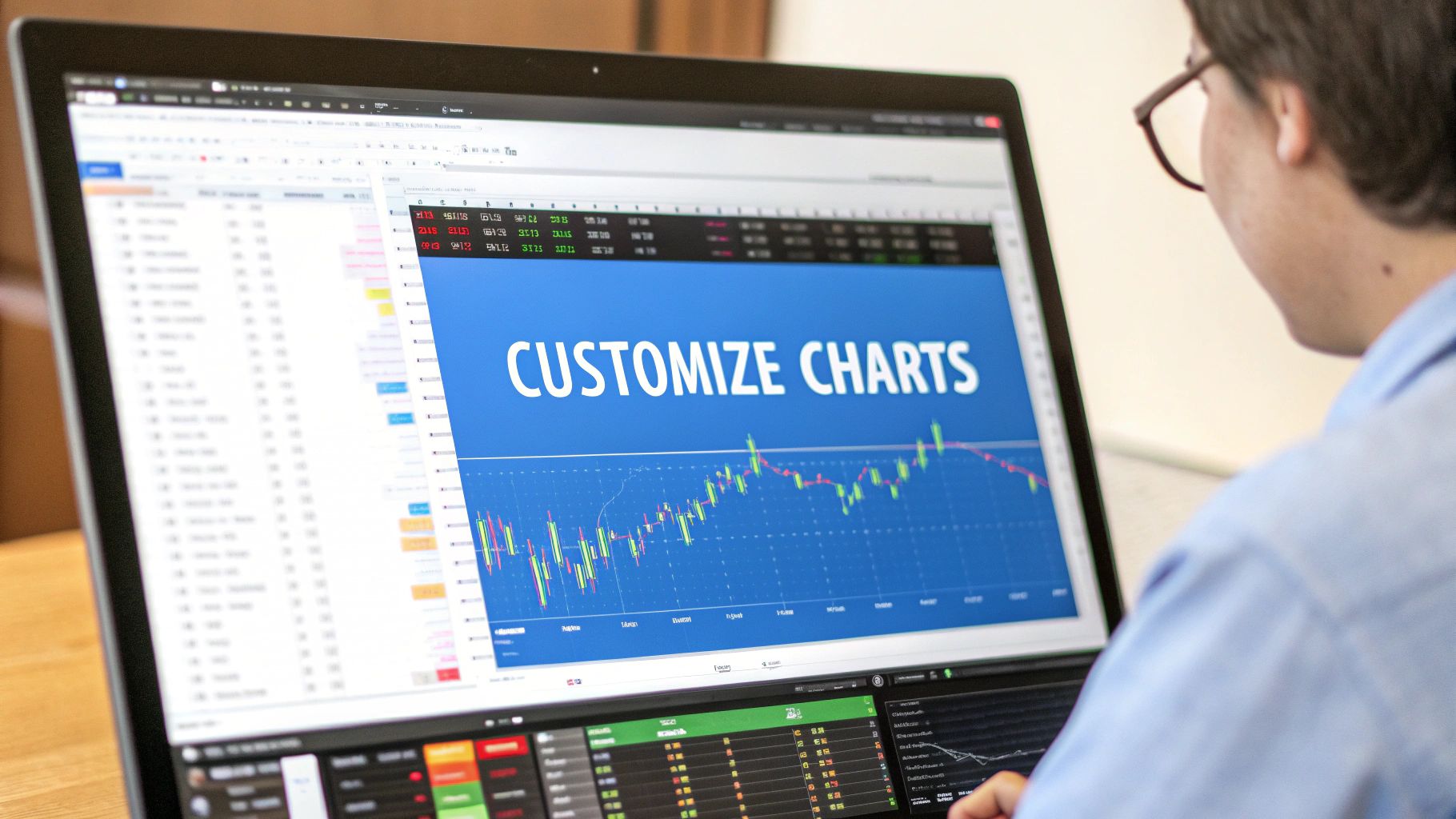How to Customize Stock Charts for Optimal Trading
The Hidden Edge of Customized Stock Charts

Standard stock chart templates often offer a limited perspective. Experienced traders know that customizing charts is key to gaining an advantage. Talking with trading professionals reveals a trend: those who personalize their charts outperform those using default settings.
Unveiling Hidden Patterns Through Customization
Why the difference? Customization lets traders visualize data according to their trading style and preferences. A day trader focused on short-term price swings might prioritize real-time data and sensitive indicators. A swing trader, however, might prefer a cleaner chart emphasizing long-term trends and support/resistance levels.
Customizing charts allows each trader to see the most relevant information. Small adjustments can reveal hidden patterns invisible to most.
Furthermore, customized charts help traders filter out irrelevant information. Today's market data can be overwhelming. Customizing charts lets traders focus on the key metrics driving their decisions. This often involves using technical indicators, essential for technical analysis. Platforms like TradingView offer over 100 pre-built indicators for customized charting. Indicators like moving averages or the relative strength index (RSI) help traders identify trends and potential reversals. Learn more about technical analysis software here.
Customization Doesn't Require Coding Expertise
Many believe chart customization requires advanced programming skills. This is a misconception. Most trading platforms have intuitive interfaces for easy customization. Even new traders can quickly personalize their charts and gain better market visibility.
The Power of Proprietary Chart Setups
Many successful traders consider their custom chart setups among their most valuable tools. They invest considerable time and effort developing and refining these setups based on market feedback and evolving strategies. This dedication underscores the importance of personalized charts for better decisions and improved trading outcomes. These custom setups are rarely shared, often kept secret. Chart customization allows traders to create a personalized command center for navigating market complexities.
Essential Tools That Transform Your Chart Analysis
Choosing the right trading platform is crucial for effective stock chart customization. Whether you're using TradingView, ThinkOrSwim, or MetaTrader, understanding each platform's strengths is key to maximizing your analysis. Let's explore what sets these platforms apart and how they cater to different trading styles.
Evaluating Platform Capabilities
Effective chart customization boils down to three core components: drawing tools, overlay options, and custom indicator support. The best platform for you will depend on how well these features align with your individual trading approach. A day trader, for example, might prioritize real-time data and responsive drawing tools for quick chart analysis. A swing trader, on the other hand, might find more value in extensive overlay options for identifying long-term trends.
-
Drawing Tools: A comprehensive suite of drawing tools is essential. Look for platforms offering a wide selection, from standard trendlines and Fibonacci retracements to more specialized annotation features. The ability to place these tools quickly and accurately on your charts is paramount.
-
Overlay Options: Overlays, such as moving averages and Bollinger Bands, add layers of analytical depth to your charts. A platform with a diverse library of pre-built overlays, coupled with the ability to create your own custom overlays, provides the flexibility needed for thorough market analysis.
-
Custom Indicator Support: For traders seeking unique analytical perspectives, the ability to create or modify indicators is invaluable. Some platforms even provide the functionality to code your own indicators, allowing for maximum customization and control over your charting environment.
Platform-Specific Examples
Traders utilize different platform-specific features to create their ideal chart setups. A TradingView user might leverage the platform’s extensive library of community-built indicators, tapping into a wealth of shared knowledge and analytical tools. A ThinkOrSwim user might take advantage of the platform’s sophisticated options analysis tools, seamlessly integrated into the charting interface. A MetaTrader user might value the platform's robust backtesting capabilities for custom indicators and automated trading strategies.
For more in-depth information on these platforms and other helpful tools, check out our guide on top stock market analysis tools for pro traders.
Matching Platforms to Trading Styles
The following table provides a concise comparison of popular trading platforms and their chart customization capabilities:
Trading Platform Comparison for Chart Customization
A detailed comparison of popular trading platforms and their stock chart customization capabilities
| Platform | Basic Customization | Advanced Features | Indicator Library | User Experience | Price |
|---|---|---|---|---|---|
| TradingView | Excellent | Excellent | Extensive | User-Friendly | Varies |
| ThinkOrSwim | Good | Excellent | Comprehensive | Moderate Learning Curve | Varies |
| MetaTrader 4 | Good | Advanced | Good | Steep Learning Curve | Varies |
This comparison highlights the core strengths of each platform. TradingView excels in its user-friendly interface and community-driven resources, providing an accessible experience for traders of all levels. ThinkOrSwim shines with its advanced integrated options analytics, offering specialized tools for options traders. MetaTrader 4 is renowned for its automated trading and backtesting capabilities, making it a popular choice for those interested in algorithmic trading. Selecting the optimal platform depends on matching these strengths to your specific trading style and analytical needs.
You can also explore our resource on How to master... for further guidance. By carefully considering your analytical requirements and exploring different platforms, you can create a personalized charting environment that maximizes your trading potential. Through customized charting, you gain the unique advantage of visualizing market data in ways others can't, empowering you to make more informed trading decisions.
Crafting Indicator Combinations That Actually Work

Too many indicators can clutter your charts, creating a confusing jumble of conflicting signals. Instead of succumbing to indicator overload, successful traders focus on a few carefully selected combinations that complement each other. This section reveals how to customize your stock charts by fine-tuning technical indicators for optimal performance. You'll learn how to move beyond the default settings and calibrate parameters to suit specific market conditions.
Calibrating Indicator Parameters
Default indicator settings rarely work optimally. Take the Relative Strength Index (RSI), for example. The standard RSI uses a 14-period lookback. However, a shorter period, like 7, might be more responsive to short-term price fluctuations. Conversely, a longer period, like 21, can smooth out the noise in volatile markets.
This customization allows traders to adapt to changing market dynamics. Similarly, adjusting the moving average periods in a Moving Average Convergence Divergence (MACD) can significantly improve its signal accuracy. Experimentation is key to finding the optimal parameters for your specific trading style and the prevailing market environment. You might be interested in: How to master...
Strategic Indicator Layering
The goal is confirmation, not confusion. Strategic indicator layering involves combining indicators that offer different perspectives on the same price action. This means that instead of relying on a single indicator, you use multiple indicators to validate potential signals.
For example, you might combine the RSI with Bollinger Bands. The RSI can identify overbought or oversold conditions, while Bollinger Bands can show price volatility and potential breakouts. A buy signal might be triggered when the RSI shows an oversold condition and the price bounces off the lower Bollinger Band. This layered approach provides a more robust signal than using either indicator alone.
Avoiding False Signals
Some indicator combinations are notorious for generating false signals. Using two lagging indicators, like the Simple Moving Average (SMA) and the Exponential Moving Average (EMA) together, can create redundant signals and increase the likelihood of whipsaws.
Additionally, relying solely on momentum indicators like the RSI during ranging markets can lead to premature entries and exits. Instead, consider using a combination of momentum and trend-following indicators during trending markets, and volatility indicators during ranging markets.
Modifying Popular Indicators for Increased Predictive Value
Professional traders often modify popular indicators like the MACD, RSI, and Bollinger Bands to enhance their predictive value. Some traders add a signal line to the RSI or adjust the standard deviation used in Bollinger Band calculations.
These modifications can improve the indicator’s sensitivity and reduce false signals. This highlights how customization can transform standard tools into powerful, personalized analysis instruments. By understanding the underlying principles of each indicator, traders can tailor them to suit their specific needs and enhance their trading edge.
Building Custom Layouts for Every Market Condition
Market conditions are constantly in flux. Trends, ranges, and volatility spikes all require different analytical approaches. Professional traders recognize this and maintain various customized chart layouts optimized for specific market behaviors. This adaptability allows them to react quickly and make informed decisions, regardless of the market’s state.
Specialized Layouts for Different Trading Strategies
Just like a surgeon uses different instruments for various procedures, traders utilize different chart setups for specific strategies. A day trader, for example, needs real-time data and responsive indicators to capitalize on short-term price movements. Their custom stock charts would typically feature tick charts, Level 2 data, and short-period moving averages.
Swing traders, focusing on trends lasting multiple days or weeks, rely on daily or hourly charts incorporating indicators like the MACD and RSI. Their priority is identifying swing highs and lows, which demands different tools than day trading.
Long-term investors, on the other hand, are more interested in fundamental analysis and broad market trends, preferring weekly or monthly charts. They focus on long-term moving averages and fundamental data overlays to assess long-term investment potential.
Seamless Transitions Between Analytical Views
Markets can change unexpectedly. A calm, range-bound market can quickly become volatile. Therefore, having a system for rapid transitions between chart layouts is crucial. Many traders use workspace templates within their charting platform. This allows them to shift from a trend-following setup to a volatility-focused layout with a single click.
For instance, a trader might have a “Trending Market” workspace and a “Ranging Market” workspace. As the market transitions, they can instantly adjust their view, ensuring they are using the appropriate tools.
Eliminating Distractions and Highlighting Key Information
A pilot attempting to land a plane with a cluttered cockpit is a good analogy for a trader with a disorganized chart. A clean, focused view is essential. Customizing stock charts helps eliminate distractions and highlight the precise information needed for a specific trading scenario.
Successful traders configure their workspaces to emphasize critical indicators and price action. Strategic color-coding is another key tactic. For example, they might highlight support and resistance levels in bold colors while keeping other indicators subtle. This helps vital signals stand out, enabling faster decision-making under pressure.
Practical Chart Customization Examples
Consider a day trader using a 1-minute chart. They might customize their chart to include the 20-period and 50-period moving averages, the Volume Weighted Average Price (VWAP), and a short-period RSI. This setup helps identify rapid reversals and momentum shifts.
A swing trader, using a daily chart, might focus on Bollinger Bands, the Fibonacci retracement tool, and a longer-period RSI. This helps pinpoint potential entry and exit points based on support, resistance, and momentum.
The following table illustrates optimal chart layouts for different trading strategies. It provides a guideline for customizing charts based on trading style and market conditions.
Optimal Chart Layouts for Different Trading Strategies Recommended chart customization setups for various trading approaches
| Trading Style | Timeframe | Key Indicators | Chart Type | Color Scheme | Special Features |
|---|---|---|---|---|---|
| Day Trading | 1-minute | 20/50 MA, VWAP, RSI(7) | Candlestick | High Contrast | Level 2 Data |
| Swing Trading | Daily | Bollinger Bands, Fibonacci, RSI(14) | Candlestick | Moderate Contrast | Drawing Tools |
| Long-Term Investing | Weekly | 200 MA, Fundamental Data | Line | Low Contrast | Economic Calendar |
As shown in the table, customizing charts allows traders to tailor their analysis for specific trading styles and market conditions. This leads to clearer insights and prevents information overload.
By customizing stock charts, traders gain a significant advantage in interpreting market data and making sound trading decisions. This focused approach streamlines analysis and empowers traders to react decisively in dynamic market environments.
Next-Level Techniques Most Traders Never Discover

Moving beyond the basics of stock chart customization can significantly enhance a trader's analytical capabilities. Advanced techniques can transform a basic charting platform, like ChartsWatcher, into a powerful, personalized analysis environment.
Multi-Timeframe Analysis on Single Charts
Seeing the bigger picture is critical for successful trading. Multi-timeframe analysis allows traders to view daily, weekly, and monthly trends simultaneously. This technique often involves overlaying different timeframes on a single chart, perhaps using indicators or separate price series. This helps traders quickly identify divergences and confirm trading signals across various timeframes, providing a broader market perspective without a cluttered screen.
Complex Conditional Alerts for Specific Setups
Timing is everything in trading. Identifying the precise moment a key setup develops can be challenging. Conditional alerts help automate this process. Unlike simple price alerts, conditional alerts trigger only when specific criteria are met. This could involve a convergence of indicators, a breakout through resistance, or a combination of high volume and a price spike. Automating this process frees up time and mental energy for more strategic analysis, enabling swift action when opportunities arise.
Volume Profile Overlays
Understanding historical trading activity can provide valuable insights. The volume profile shows where most trading has occurred, often revealing hidden support and resistance zones. Overlaying this profile on a price chart can highlight potential areas of price reversal or consolidation. This visualization goes beyond basic support and resistance lines, offering deeper insights into price dynamics and potential large order clusters.
Order Flow Visualization
The forces of supply and demand drive price movements. Order flow visualization reveals the underlying buy and sell pressure in real-time. Incorporating order flow into your charts provides a direct view of market sentiment. However, it’s important to avoid information overload. Start with a simple bid/ask spread indicator and gradually add more advanced tools as your understanding of order flow deepens.
Modifying Indicator Scripts
Customization can take your analysis to the next level. Modifying existing indicator scripts allows for highly personalized insights. You don’t need to be a coding expert to make effective adjustments. Many platforms allow for tweaking indicator parameters or combining elements of different indicators. Begin with small modifications to built-in indicators and experiment to understand the impact on generated signals. This can lead to unique insights tailored to your trading style.
Optimization Strategies for Maintaining Platform Performance
Advanced chart customizations can sometimes impact platform performance, especially with real-time data. Regularly review your active customizations. Removing unused indicators and optimizing your workspace layout can improve rendering efficiency. This proactive approach ensures your ChartsWatcher setup remains responsive and reliable, even with sophisticated configurations. Implementing these techniques allows for deeper market insights and a trading environment perfectly suited to your needs.
The Psychology of Color in Trading Performance

The visual presentation of your stock charts, especially color, plays a larger role in your trading choices than you might realize. While tweaking indicators and layouts is important, refining your color schemes can significantly boost pattern recognition and minimize decision fatigue, a real concern during long trading days.
How Color Impacts Trading Decisions
Color triggers psychological reactions and shapes how we process data. Red, for instance, often signals urgency or danger. This can potentially lead to rushed sell decisions. On the flip side, green typically represents growth and stability, perhaps tempting you into early buy entries. Recognizing these subconscious connections is crucial for building a chart setup that promotes rational trading.
Contrast Hierarchies for Improved Focus
Skilled traders know the power of contrast hierarchies. They use color contrast strategically to draw their attention to the most vital price action on their charts. Think of a chart where key support and resistance levels pop in vibrant, contrasting colors, while less crucial indicators fade into the background with muted tones. This visual hierarchy immediately guides the trader's focus to the essential information, enabling quicker responses and more confident trades.
Optimized Color Combinations for Different Environments
The best color scheme depends on both your personal preferences and your trading setup. A brightly lit room needs a different palette than a dimly lit one. High-contrast combinations excel in bright spaces, while lower contrast with darker backgrounds reduces eye strain in darker rooms. Don't forget about your monitor's color profile. A poorly calibrated monitor can distort colors, undermining a carefully selected scheme.
- Bright Environments: A dark background paired with brighter, contrasting indicator colors is often effective.
- Dark Environments: A lighter background with softer, calming colors can be more comfortable.
Reducing Eye Strain During Extended Market Analysis
Long hours analyzing markets can strain your eyes, affecting your focus and decision-making. Customize your stock charts with color palettes that minimize eye fatigue. This usually means avoiding overly saturated colors and favoring softer hues.
- Soft blues and greens: These colors are known to be easier on the eyes.
- Muted grays and browns: These can create a calming backdrop for your charts.
- Avoid highly saturated reds and yellows: These can be visually jarring, especially during extended use.
The Impact of Customization on Trading Consistency
What might appear to be a superficial change can noticeably improve your trading consistency and psychological resilience. A well-designed color scheme reduces cognitive load and creates a visually comfortable environment. This helps you make more objective trading decisions, free from the subtle influences of color psychology. Personalizing your analytical tools and visual setup is a key difference between average traders and consistently profitable ones. Platforms like ChartsWatcher allow you to easily experiment with various color schemes to find what works best for you, further improving your trading experience.
Turning Custom Charts Into Profitable Decisions
The ultimate test of any customized stock chart lies in its ability to improve your trading performance. This section offers a practical approach to integrating your personalized ChartsWatcher charts into a robust trading methodology. We'll examine how to effectively test new setups and refine your approach over time.
Backtesting and Forward-Testing Your Custom Setups
Before risking real capital, thorough testing is paramount. Backtesting allows you to apply your customized chart setups to historical market data. This helps assess their potential effectiveness and identify any shortcomings. ChartsWatcher’s powerful features make backtesting efficient and insightful. For example, backtesting a new moving average crossover strategy on ChartsWatcher can reveal its historical win rate and average profit/loss.
However, past performance is not indicative of future results. Forward-testing, which involves applying your setup to live market data with smaller position sizes, provides a critical real-world validation. This helps confirm backtesting results and fine-tune your strategy in a live market environment.
Documenting Effective Configurations: Building Your Playbook
As you identify successful chart customizations, detailed documentation becomes essential. Create a personalized "chart customization playbook" within ChartsWatcher. This playbook should specify each setup’s objective, the indicators used, their parameters, and the entry/exit rules.
Consider this your trading journal, a living document that grows with your trading experience. Think of it as your own proprietary trading manual, constantly being refined with your latest discoveries.
Troubleshooting and Refinement: When Customizations Don't Work
Not every customization will lead to profits. When a setup underperforms, systematic troubleshooting is necessary. Review your backtesting and forward-testing data. Are there particular market conditions where the setup fails? Do the indicators require adjustment? Perhaps the entire setup needs reconsideration. ChartsWatcher's flexibility allows for rapid modifications and iterative enhancements to your charting strategies.
Adapting to Evolving Markets: Continuous Improvement
Markets are in constant flux. A strategy that works today may not work tomorrow. Therefore, ongoing refinement of your custom stock charts is vital. Regularly review your playbook, incorporate new indicators, and experiment with different parameters. This continuous improvement process ensures your ChartsWatcher setup stays aligned with current market conditions, maximizing your potential for success.
Ready to enhance your trading with personalized, powerful chart analysis? Start your free trial of ChartsWatcher today and unlock the potential of customized charting! Discover ChartsWatcher

